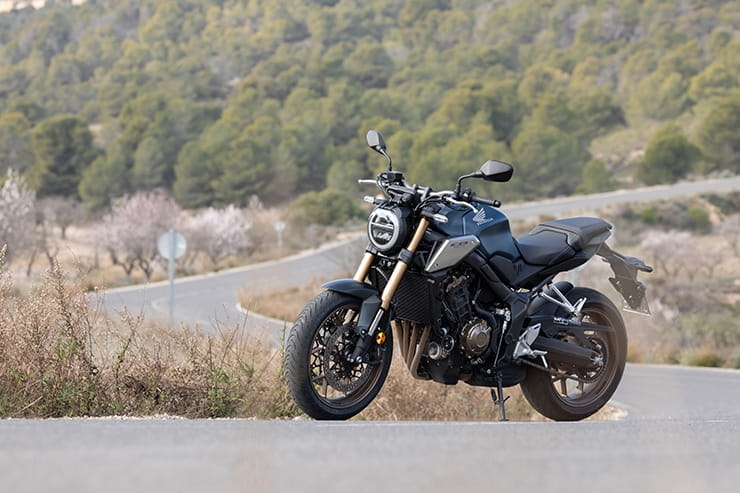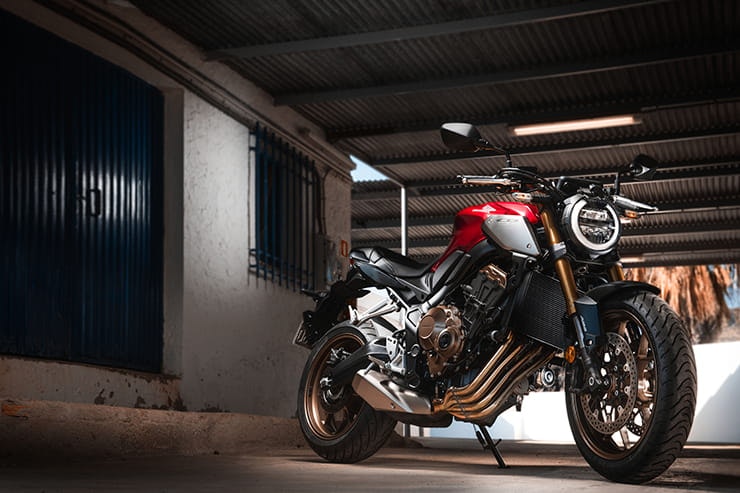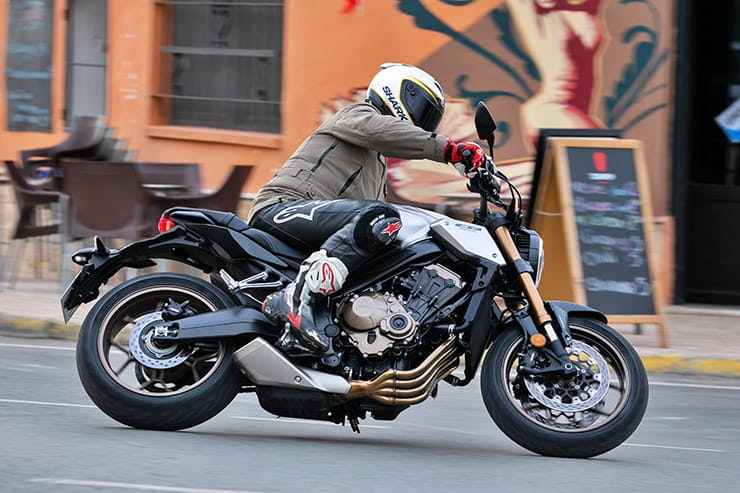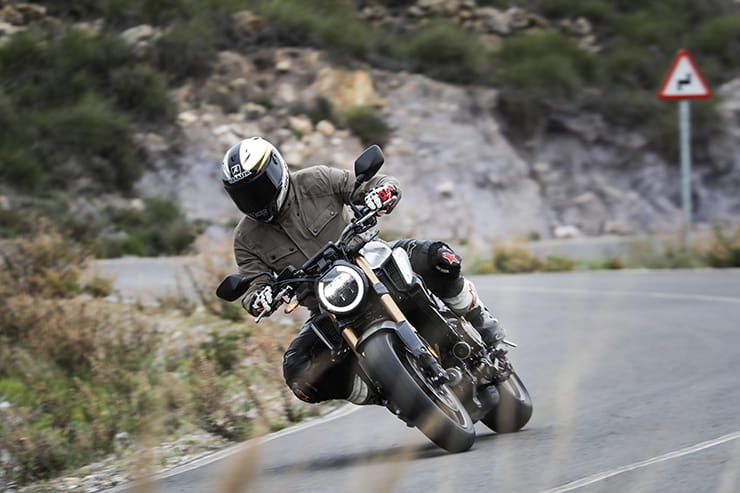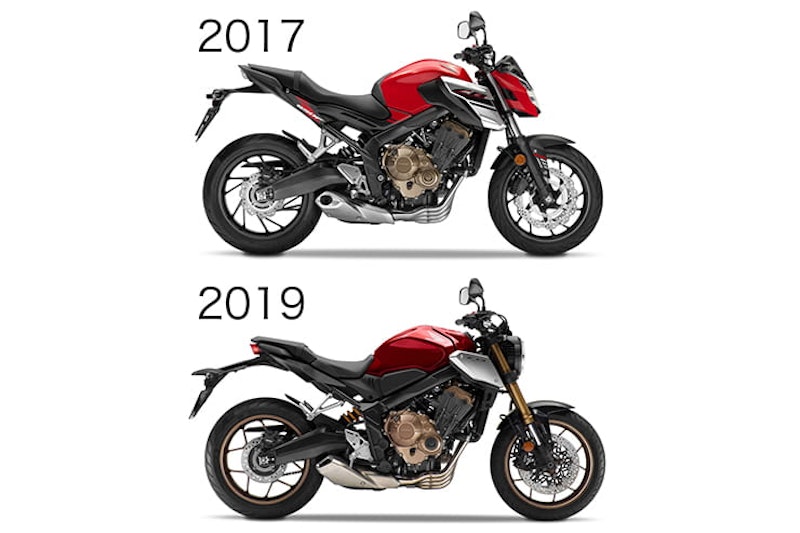HONDA CB650R (2019) | REVIEW
BikeSocial Road Tester
28.01.2019
In 2014, Honda launched the fully faired CBR650F and naked streetbike CB650F. Mid-priced, un-showy, high-revving inline four-cylinder middleweights, they joined an A2-licence compliant class crowded with mostly twin-cylinder competitors. Like their rivals, the Hondas were built down to a price – but their engine configuration and character were a significant point of difference. So was their power output – mid 80s horsepower put them ahead of the pack.
A 2017 revamp added a few bhp and uprated suspension, but this year sees the CBR and CB’s first major revamp – and BikeSocial is in southern Spain at the launch to ride them both. The joys of platform engineering mean the updates to the CB650R and CBR650R are almost identical. Both bikes share tuned-up engine, frame, suspension, brakes, wheels, electronics, clocks, steering geometry, seat – just about everything except handlebars, bodywork and tyres.
Details of the faired CBR650R are here.
Honda say the naked CB’s update is designed to shift its appeal towards younger riders, adding youthful zeal by increasing the engine’s power output and chassis performance still further, tweaking the riding position, and garnishing the plot with a layer of electronic and feature sophistication. The CB’s overhaul is finished off with a Neo Sports Café styling makeover, placing it between the CB300R and CB1000R in Honda’s range. The overall result is a distinct upturn in perceived quality; better than fitting a wicker shopping basket.
Or maybe not: while the faired CBR650F is already favoured by predominantly younger riders, Honda say the naked CB650 has a wider demographic spread, with 43% of its riders under 40. Which also means more than half of them are over 40 – and, according to Honda, a quarter are 51 - 60 year-olds. Even more delightfully, 10% are over 60 – presumably these are the guys and girls nostalgic for the fabulous Honda 400-4 of the 1970s, seduced by the CB650F’s imitation of its signature diagonally swept exhaust headers. More power to them, we say. Literally.
Honda CB650R prices, PCP deals, and availability
In dealers now
OTR: £6999.00
Colours: Graphite Black, Matt Crypton Silver Metallic, Matt Jeans Blue Metallic or Candy Chromosphere Red
Honda PCP deal
Accessory packs
Sports pack: belly pan, seat cowl, tank pad, quickshifter – £605.00
Comfort pack: heated grips plus fitting kit, tinted screen, 12v socket – £385.00
Power and torque (claimed)
93.9bhp @ 12,000rpm
47.2 lb.ft @ 8000rpm
The CB’s 649cc inline four motor is, as per the CBR650R, a pepped-up version of previous CB650F’s engine. Claimed power is up by 4.1bhp and 1000rpm, from 89.8bhp @ 11,000rpm to a peak of 93.9bhp @ 12,000rpm. Peak torque is the same 47.2 ft.lb as before, but now up from 8000rpm to 8500rpm.
Engine, gearbox and exhaust
But oh my life... how many revs, exactly? The CB650R, naked as the day it was born (about 250 miles ago, according to its odometer), rips through its neat gearbox like gammon on a bacon slicer as the crazy-ass Spanish tarmac unfolds in a meat feast of mid-speed switch-back lefts and rights. The quick(ish)shifter (£295 accessory) skips up and down from second to third and back again, occasionally straying into higher gears but mostly with the digital tacho needle flicking between 6000 and 11,000rpm, and serving to demonstrate the motor’s astonishing flexibility and smoothness. Especially for a budget middleweight.
With a new redline of 12,500rpm and a rev limiter up around the 13,000rpm mark, but with crisp throttle response and decent drive from 4000rpm, that’s a spread of nearly 10,000rpm to play with. And the CB650R feels fit and up for it at most points in between, potent and fully formed; it’s a proper, grown-up motorbike, with none of their cut-price, plastic, Christmas cracker feel you can get with some other A2-licence compliant twins.
As the CB shares its engine with the CBR650R, the list of technical changes are identical (so if you’ve already rear the CBR650R report, this will sound familiar): the old unit’s 90-odd bhp has been lifted by 4bhp at peak, achieved by letting the four cylinder motor rev higher with changes to valve timing, appropriate tuning of intake and exhaust, and a new ECU map. It’s effectively letting the engine breathe better at high revs, which extends its ability to make useful torque higher up the rev range – torque multiplied by gearing equals power, and so even though the engine makes the same peak torque figure as before, everything is shifted north slightly, and it can make torque for longer. That’s why peak torque is now 500rpm higher, at 8500rpm, and peak power is 1000rpm higher, at 12,000rpm.
However, without increasing capacity, you don’t get something for nothing – close inspection of Honda’s before-and-after dyno curve shows the new engine makes less torque – and therefore power – pretty much all the way up to 8000rpm. This won’t – and doesn’t – make the new engine feel suddenly gutless, but it shows how modern fuelling and electronics allow manufacturers to manipulate and tailor power curves to a fine degree.
And the CB650R has a noticeably zingier top end than the old 650F, if you hang on for long enough to get there. Because the trade-off for a howling, whizzing four-cylinder is you miss out on the short-revving, more compressed power delivery of a twin. It’s swings and roundabouts: two years ago I drag-raced a CBR650F alongside a parallel twin Kawasaki Ninja 650 and found the Kawasaki got the initial drive off the line, but the Honda rapidly pulled it back and overhauled it as it made its extra performance count.
So if you spend much of your riding life buzzing round town, scooting away from traffic lights and generally interacting with urban traffic, maybe an inline four isn’t the most ideal powerplant. But if you also venture out on the open road, with faster bends and riding with a more... er... ‘sporting’ intent, the extra zip of the Honda’s inline four will suit. It’s nice to have the choice. For me, the Honda’s high-revving headroom is more fun; comparable twins run of puff too quickly and I keep bumping in the rev limiter on the road. There’s no danger of that on the CB650R.
It’s a smooth power delivery too; long, linear, no dramatic dips or troughs as the revs rise. And it’s smooth in terms of vibration too: a complaint levelled at the old CB650F motor was its high-pitched buzzing through the bars and pegs at a cruising 5000-6000rpm. This is secondary vibration, and it’s caused by the differential in non-sinusoidal piston motion inherent in crank geometry. It manifests at precisely the right frequency in inline four engines (at around 5000-6000rpm) to sometimes cause a condition known as ‘white-finger’ – where blood is drained from the extremities, usually fingers, causing tips to go white and a burning sensation, or numbness. Lots of riders will have experienced it to some degree.
The usual solution is to include one or more balance shafts or gears in the engine design – literally, a tuned counterbalance gear driven by the crank and spinning in opposition to balance secondary vibration.
But some engines don’t have them, and the CB650F motor is one that doesn’t – which is why it buzzed enough to annoy some owners. Solutions that don’t involve redesigning the motor are a bit Heath Robinson, but can be effective. They include rubber-mounting handlebars and footpegs, or even filling the hollow handlebars with hard-setting foam. If you own a BMW S1000XR, you’ll know all about it.
Or, in the CB650’s case, Honda’s fix is to change the engine’s top rear mounting points – which is, after all, how some engine vibration gets communicated to the rider. The old motor was directly bolted to the frame, on each side. The new CB650R hangs off hanger plates instead, isolating the engine more effectively than previously.
In terms of total power output the CB650R is now, like the CBR, a hair’s breadth away from the 94bhp upper limit for the bike to remain A2 licence compliant. This means the CB can still be restricted down to 47bhp – like the CBR, to this it uses plastic intake funnels with bores restricted by 86%, and a suitably limited ECU map. Honda say it will take an hour to derestrict when you get your full licence.
Other CB650R engine updates are a new slipper clutch with lighter lever action (Honda say it’s 12% lighter; and it’s noticeably two-finger light in town), and the underslung exhaust exit is now angled upwards, towards the rider. Combined with new twin air intakes, it gives the CB650 a slightly more aggressive riding soundtrack.
Economy
Like the CBR, the CB’s new engine performance has a knock-on effect on fuel consumption: Honda say both bikes use slightly more fuel than before – 57.6mpg compared to the previous engine’s 59.3mpg. In Spain, the CB’s actual fuel consumption averages around 45mpg (according to the on-board mpg reading), which is a tank range of around 150 miles to empty and so needing a filling station every 120 miles or so.
The new CB’s tank has shrunk by nearly two litres: at 15.4 litres it’s down from the CB650F’s 17.3 litres – the new clocks have meant moving the ignition barrel behind the top yoke instead of in front, using up valuable tank space. BikeSocial’s supercomputer says that’s around 30 miles less tank range on the new CB. Don’t know about you, but I find this sort of thing annoying; tank range is one thing bikes do much, much worse than other forms of transport (electric nonsense aside) – so anything that reduces it is irritating. It’s not so much the ability to keep riding in one go, it’s the pain in the ass of having to break into your daily commute twice a week, say, instead of once.
Suspension, chassis and weight
As with the motor, the CB and CBR also share a common chassis and so the CB’s frame is the same pressed steel twin spar as the CB650F. The swingarm pivot plates are now pressed sections instead of cast, saving 1.9kg. The subframe is still welded to the frame, but 60mm shorter and angled upwards and for a tidier back end. Sales of tail tidies for CB650Rs should do well.
Forks are non-adjustable 41mm Showas, now upside down and bearing a new acronym: SFF (Separate Function Fork) instead of the SDBV (Showa Dual Bending Valve). The new forks have damping in one leg and springing in the other, with predictable claims for less weight, lower friction and improved ride quality. Showa claimed all that with the SDBV forks on the CB650F two years ago. At the back, the cantilever Showa shock gets the addition of a rubber bump stop and has seven-way preload, but no damping adjustment. Rake, trail and wheelbase are as per the previous CB650F.
Honda claim the naked CB650R is six kilos lighter than the CB650F, at 202kg wet. The ‘wet’ but is important, because a third of that weight reduction comes from carrying less fuel, and – amazingly – less oil. The old CB650F held 3.5 litres; the new motor takes 2.7 litres – 800ml less, which weighs about half a kilo. There’s no difference internally, apart from the new dipstick is longer. So that means since 2014, every CB650F and CBR650F sold has been carrying 800ml more oil for no reason. The earth will die screaming.
The rest of the weight saving comes from the frame (1.9kg lighter), and from details like a shorter subframe and changes to wheels, suspension and component details.
Brakes, wheels and tyres
The CB650F’s ABS brakes were perfectly adequate but fairly unsexy conventional two-pot sliding calipers, gripping a pair of unnecessarily showy wavy discs. The new CB650R gets it the right way round – the calipers are four-pot Nissin radials acting on a pair of conventional discs (10mm down in diameter). Cast aluminium wheels are a new slim-spoke style, with 120/70 and 180/55 Metzeler RoadTec 01s supplying the grip.
Ergonomics and comfort
The CB gets a slightly sportier riding position – the flat, tapered bars are now set 13mm further forward and 8mm lower than previously, seat height remains the same 810mm, and the footpegs switch to neater, sportier aluminium with no rubber inserts, set 3mm further back and 6mm higher than before.
The result is little change to the CB650R’s nicely balanced stance. The rider’s upper body is forward-canted, but not as shoulder-barging as a Ducati Monster – and also not over-exposed to wind blast and bearable up to around the ton.
Handling
The CB650’s flat bars give the bike a nimble, agile feel, with the extra leverage over the front end immediately noticeable. It flicks from side to side with ease, at any speed, and is perfectly balanced charging through traffic. There’s no trace of instability at speed – bundling the CB onto your chosen line is a total joy.
Ride quality is, like the CBR650R, outstanding – Honda are master of persuading budget, non-adjustable suspension to feel higher quality than it is. The CB feels more controlled and steady on its springs than the CBR650R, possibly because they’re better set-up to balance the weight of the rider in the middle of the bike rather than leaned over the front end. Either way, the CB feels perfectly poised.
And the CB650R’s Metzeler tyres are good too – with an immediately softer and gripper feel, and some heat in them after a decent ride on cold roads.
Equipment
The previous CB650F had a cheap, monochrome dash – the new CB650R gets the same, larger dash as the CBR650 – with gear position indicator, fuel gauge, tacho and mpg. At night it’s plenty bright enough, but even in dull daylight the off-colour digits on a black background just aren’t clear enough, with too little contrast to be comfortable. Maybe it’s my age but, behind a tinted visor, the dash is really, really dim.
The CB650R also gets Honda’s basic traction control. No settings, just on or off. But, handily, you can turn it off while riding just by holding down a button on the left bar – just in case you feel the need to hoist a monster.
Other new equipment includes emergency brake lights – the indicators front and rear flash under hard braking (but before the ABS cuts in).
2019 HONDA CB650R: VERDICT
The CB650R is a good chunk cheaper than the CBR650R – at £6999 against £7729, that’s a significant saving for having better tyres as standard, greater agility, less overall weight, a more upright riding position and no fairing. Oh, and I think it looks better too.
Against its A2-compliant rivals, it’s harder to place the new CB. Its inline four motor is still unique in that class (if you discount Kawasaki’s Z900 in 94bhp guise, to permit detuning to an A2-friendly 47bhp). And while Yamaha’s parallel twin MT-07 is £650 cheaper, lighter and hilariously flippant, the suspension’s not as good as the Honda’s – and it makes 74bhp; significantly less than the CB. Same deal for Kawasaki’s parallel twin Z650 – £650 cheaper, 67bhp, and quite a lot less fun than the CB. Suzuki’s base SV650, a 75bhp V-twin, is £1300 less than the CB – but it’s so much less impressive on spec and performance.
So that puts the CB650R on the top in terms of spec, but also price.
If the Honda’s ability to be limited to an A2 licence isn’t important to you, things get more interesting. KTM’s 790 Duke (which is available in A2-comptible, 94bhp form) makes 105bhp, costs £8799 – £1800 more – and is a total riot to ride. Kawasaki’s full power Z900 is £8549, Yamaha’s MT-09 is £8399 and Suzuki’s GSX-S750 is £7899. All more expensive, but all significantly more powerful than the CB650.
Which in turn puts the CB650R at the bottom in terms of performance, but also price.
You pays yer money.
Three things I love about the CB650R
• engine layout – one of the last of inline four middleweights, and it’s good to make them howl
• looks – who doesn’t love diagonal slashed exhaust headers?
• handling – agility, ride quality and chassis balance; what quality budget suspension should feel like
Three things I don’t…
• dim dash – brighter, please – or invert it
• shrinking tank – 120 miles isn’t the worst, but bigger is better
• er, that’s about it
2019 Honda CB650R Specification
To insure this bike, click here
Honda CB650R Review | The middleweight sports Honda is back
BikeSocial sent roving road tester, Simon Hargreaves, to Spain for the international riding launch of the 2019 Honda CBR650R and CB650R and here's his introduction to the bikes and first impressions.. (CB650R at approx 4:40)
